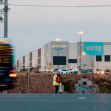A battle is raging In Amazon’s Bessemer, Alabama, warehouse. On Monday, February 8, 2021, the National Labor Relations Board (NLRB) will mail ballots to 5,805 workers at the facility. These folks then have seven weeks to decide whether they want the Retail, Wholesale and Department Store Union (RWDSU) to represent them. Those represented will not include drivers, seasonal employees, or professional employees.
Some workers are in favor of unionization, citing too-short and infrequent bathroom breaks, overheated facilities, and mandatory overtime orders being issued mere hours before the shift starts.
Amazon management, on the other hand, argues that the workers in the Bessemer plant are already getting everything they could possibly want: $15.30 per hour starting pay (Alabama has no state minimum-wage law, and the federal minimum wage is $7.25 per hour), health care, vision, dental benefits, a retirement plan, and direct communication with management.
Long criticized for work conditions that cause serious injuries and such low pay that workers are forced to rely on public benefits, the company strongly opposes the presence of unions in its facilities. To prevent them from making inroads, they have utilized heat maps, data visualization, internal spies, and Pinkerton agents.
Amazon has been holding mandatory anti-union briefings during working hours and has even gone so far as to post anti-union fliers on the doors inside bathroom stalls asking, “Where will your dues go?” (In Alabama, a right-to-work state, workers in unionized workplaces cannot be required to join the union or pay any dues or agency fees.) A pro-union worker who required anonymity for fear of retribution said, “I feel like I’m getting harassed,” about the bathroom fliers.
This is the biggest labor battle in Amazon’s history in the U.S. If the workers vote yes for the union, this would be the first Amazon warehouse in the U.S. to unionize. If Bessemer unionizes, the potential exists for the 400,000 operations staff at the hundreds of other U.S. Amazon warehouses to follow suit. Labor Studies professor Rebecca Givan of Rutgers University said, “Amazon workers all over the country will see there is a path to have a voice on the job. Collective action is contagious.”
Heather Knox, an Amazon spokesperson, said, “We don’t believe this group represents the majority of our employees’ views. Our employees choose to work at Amazon because we offer some of the best jobs available everywhere we hire, and we encourage anyone to compare our overall pay, benefits, and workplace environment to any other company with similar jobs.”
Unionization could result in battles for higher wages and improved working conditions, which could stall Amazon’s growth. The negotiations over those items would likely increase costs and potentially impair efficiency. Amazon claims workers don’t need a union coming between them and management, sending nearly five text messages each day to the Bessemer workers, begging them not to abandon “the winning team.”
Unionization in the U.S. has been in decline for decades. Participation in unions was about 11% last year, down from 30% of nonagricultural workers in 1964. Older giant companies, like UPS, are unionized, but major nonunion employers include newer companies like the Gap and Walmart.
Amazon has been a target for labor groups for years, according to Richard Trumka, president of the AFL-CIO, which is lending personnel and strategic guidance to help the RWDSU. “We’ll give them whatever they need to help them win. It’s an important, important drive,” he said.
Amazon’s appeal is that it’s a major force in logistics, transportation and retail, and it added 400,000 workers between January and October of last year, primarily to its warehouse and delivery operations. It’s one of the nation’s largest employers (more than 1.37 million Amazon and Whole Foods workers in the U.S.) and has opposed the unionization of its domestic workforce. An attempt at unionization in Middletown, DE, failed in 2014, and that was the closest to success of any attempt so far.
In 2019, an employee who spoke out about working conditions in his Staten Island warehouse called for unionization. He was fired for “violating a safety regulation at the facility.” Other warehouse workers who spoke out against unsafe conditions have also been fired.
Amazon has several warehouses in Germany where the right to form a union is enshrined in the country’s postwar constitution, so those warehouses are unionized. Much of the rest of its warehouse staff in Europe is union, as well.
Here at home, however, there’s been fresh scrutiny over Amazon’s treatment of warehouse workers. Warehouse employees raised concerns about their safety due to the pandemic, and managers initially failed to take enough precautions, workers said. Amazon has since put more measures in place to address concerns, but those measures do not address the pre-pandemic criticisms of inadequate bathroom breaks, overheated facilities and overly aggressive performance targets for workers.
Because many of the Bessemer workers are Black, the union has framed the fight around “respect and dignity” as well as pay. RWDSU President Stuart Appelbaum said, “We see this as much as a civil rights struggle as a labor struggle.” Appelbaum has been outspoken about Jeff Bezos and the way he built his business. He said, “Jeff Bezos’s business model for Amazon was feasting on public subsidies, paying little or no taxes and dehumanizing and mistreating his employees.”
One worker who supports the union, Darryl Richardson, says bathroom breaks are too short: sometimes reaching a bathroom requires a lengthy walk through a massive warehouse. He says that too much time away from picking items off shelves (time that is tracked by computers) can lead to reprimands, slow raises or promotions, and even termination. He spoke up at a mandatory meeting for workers, where management suggested the purpose of the union was to raise money for union leaders’ cars and meals. Richardson said, “They say, ‘Darryl, can’t you give us a chance to fix it?’” He replied, “I’ve been here ten months. How much chance do you need?” A manager took a picture of Richardson’s employee badge, an attempt at intimidation, according to Richardson.
Alabama is a “right to work” state. In part, this means employees of unionized workplaces cannot be required to pay union dues if they choose not to. This fact could help RWDSU in the election, as employees who are indifferent to the union would not need to pay dues, even if the union wins the election. Appelbaum said, “Amazon is trying to make dues the issue, even though people don’t have to pay dues.” The union needs yes votes from the majority of the ballots cast, rather than from a majority of the actual number of workers. More than half the workers at the facility have signed cards authorizing RWDSU to represent them, so Appelbaum is cautiously optimistic: “If it weren’t for employer intimidation and interference I have no question we would win.”
Amazon has set up an anti-union website that discourages workers from joining the union drive. At its captive-audience mandatory anti-union meetings, Amazon shows videos and PowerPoint presentations that denigrate unionization. One anonymous worker said, “Amazon is throwing down their throat that the union is going to take your money.” The worker also said that as the vote approaches, managers come by workstations to hand employees water bottles and candy.
Mandatory worker meetings must end 24 hours prior to the ballots being mailed out. If workers vote to join the RWDSE, Amazon’s fight against unionization will have just begun.
Senator Bernie Sanders tweeted last month, “If Amazon workers in Alabama - a strong anti-union state - vote to form a union, it will be a shot heard around the world. If they can negotiate higher wages and better working conditions in the South, it will benefit every worker in America.”
“If it’s successful, I think it will send a message that there is some hope for workers to organize,” said Tom Kochan, MIT professor of industrial relations, work and employment. “But it’s a big uphill battle because you’ve got to organize one warehouse at a time, which takes an enormous amount of resources.”
AFL-CIO’s Trumka said, “This is just the beginning. I can promise you this is not the last effort.”






